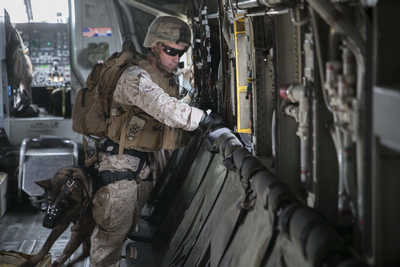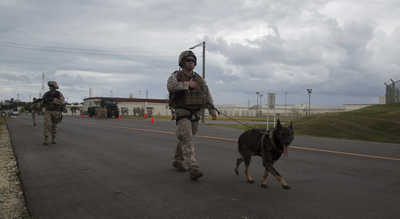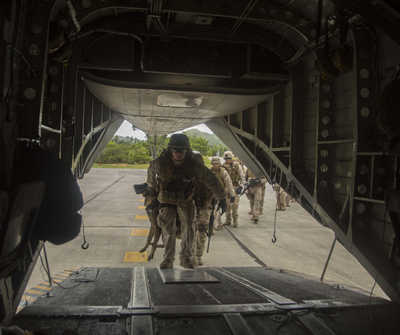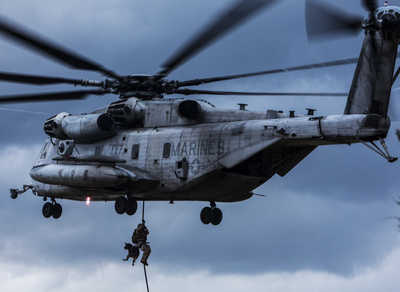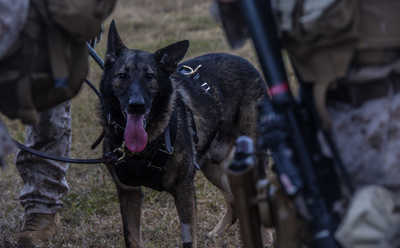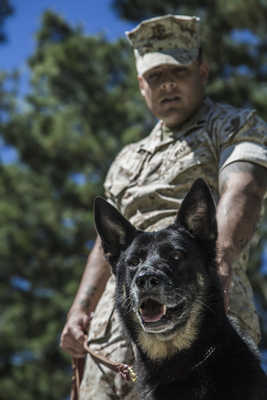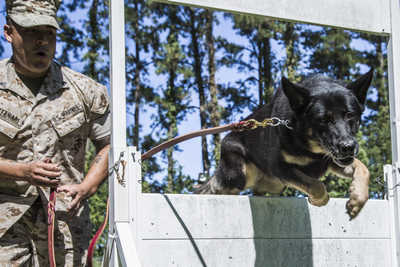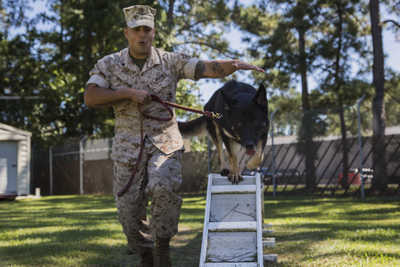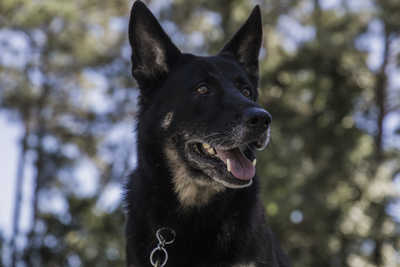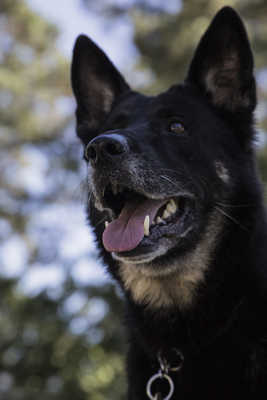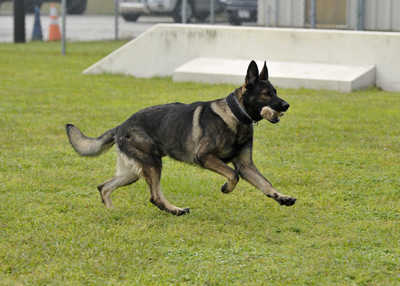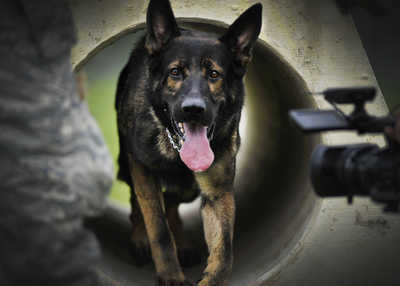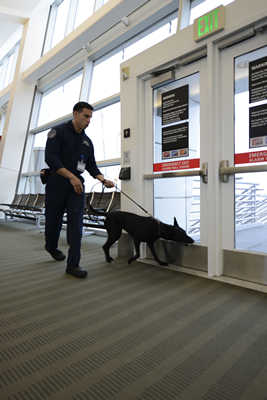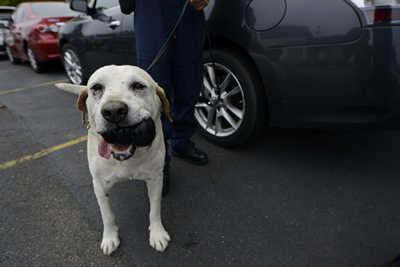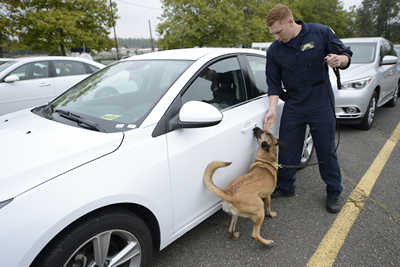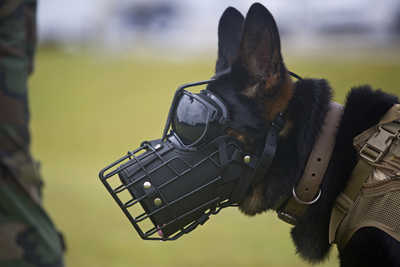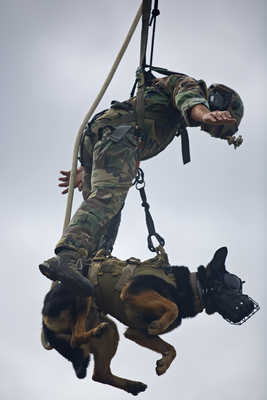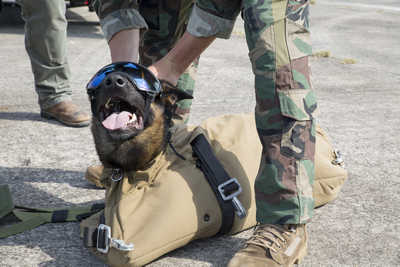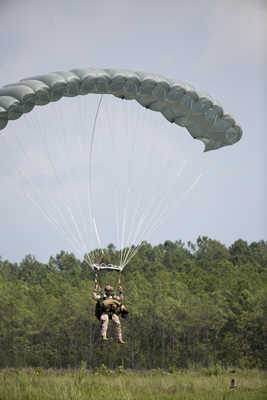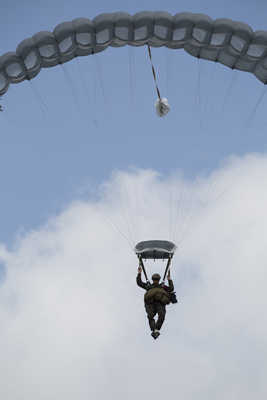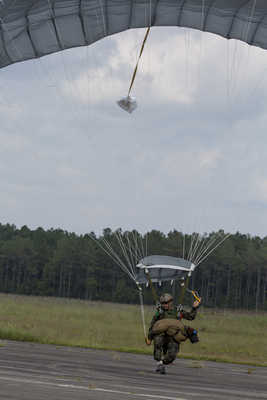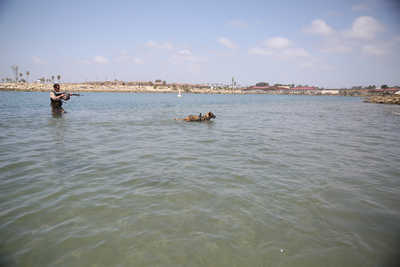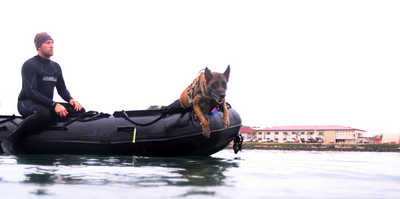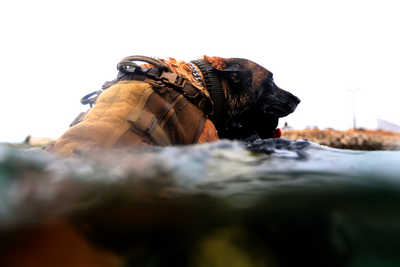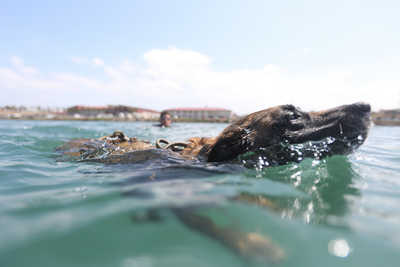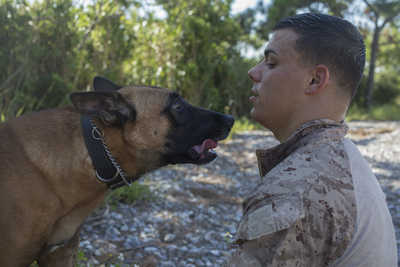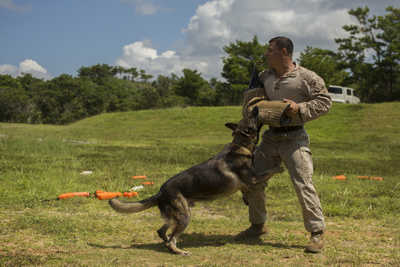Articles and Photos of Interest
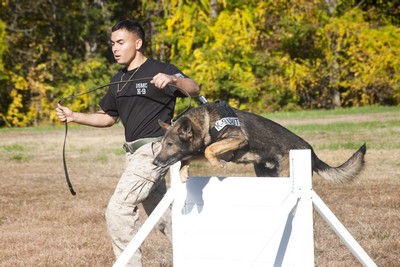
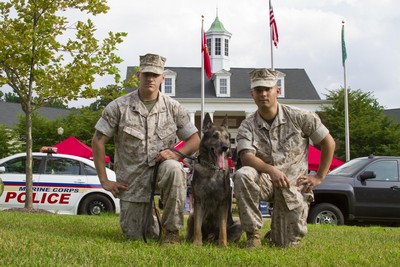
Face of Defense: Marine Dog Handlers Lead the Pack
9/9/2016 - A Marine looks down at his dog and confidently commands him to sit. The four-year-old German shepherd complies, looks to his handler for approval and awaits the next set of directions.
When the handler makes eye-contact with the dog, smiles and a pats him on the head, the 76-pound military-grade trained living machine delightfully wags his tail, looks straight ahead and patiently waits to hear his handler's voice again.
The Marine Corps' military occupational specialty 5811 -- Military Police -- is a challenging job. But MPs who consider themselves alpha dogs might have the opportunity to work with man's best friend by competing to become a 5812, Military Working Dog Handler.
"It's definitely a job you shouldn't take for granted," said Marine Corps Sgt. Shawn R. Edens, a kennel master with the security battalion at Marine Corps Base Quantico, Virgina. "How many people get to go to work and work with dogs? That's a pretty cool job."
Edens was a lance corporal attached to 3rd Marine Expeditionary Force, 3rd Law Enforcement Battalion, at Marine Corps Base Smedley D. Butler in Okinawa, Japan, when he earned the title of dog handler after winning a peer-to-peer competition board, soon afterward he received orders to depart for Quantico.
Peer-to-peer competition boards are commonly held throughout the Marine Corps in order to allow exceptional Marines to compete against one another answering questions about the Marine Corps and their MOS. Although competition on the board is not a requirement to earn the dog handler title, it is typically one avenue the MP community uses to reward Marines with the sought-after opportunity.
After recruit training, prospective MPs attend the MOS school at Fort Leonard Wood, an Army base in Missouri, and then ship to their first duty station. Marines who are selected to become dog handlers will attend the Military Working Dog Basic Handler Course, located at Lackland Air Force Base in San Antonio, Texas, for a six week course that will qualify the Marine as a basically-trained handler.
"The Marine Corps grooms Marines before they leave to the school house to ensure (they're successful) in the school," said Marine Corps Cpl. Braxton H. Rico, a military working dog handler with the security battalion at MCB Quantico.
Rico was on a training operation when he saw dog handlers in the field working with the MPs and realized he wanted to become a dog handler. He won a board in March 2015 and met Edens. He also met Segal, the dog Edens last handled, who is now Rico's first dog.
"I worked with different dogs at the schoolhouse before I came to Quantico," Rico said. "Segal has different temperaments than the dog I worked with at Lackland and made some challenges for me. Sergeant Edens helped me overcome those challenges to better myself and my work with Segal."
Upon Rico's arrival to the kennels at Quantico, Edens only had a month to train and teach him about Segal's temperament. Since then, Edens has progressed from dog handler, to trainer, to kennel master -- which is a staff sergeant's billet.
"As a kennel master, I mostly coordinate events, trainings, and ensure responsibilities are upheld in the kennel," Edens said. "I'm past the dog handling phase, but my love for the job is still the handler side."
Edens believes Marines who want to become a dog handler need to compete on a board as soon as they can. He feels that the more time the handlers have with dogs, the better understanding they will have of dog handling.
"Once you get into the canine community, you are in a specialized billet that takes people years to attain," he said. "It's a challenge, but it's worth it. In the end, you get to work with dogs and earn the pride of being a Marine."
Dogs and dog handlers from around the U.S. and overseas are trained at Lackland, Edens said. They are trained to patrol, scout, search buildings and detect either narcotics or explosives. Training methods take into account each dog's natural personality.
"By no means is this job easy," he said. "You're in charge of this dog, who basically has a mind of a three year old, so you're constantly keeping an eye on him while ensuring you take care of him. We need to bathe them, feed them, play with them, exercise with them and keep their medical records up-to-date."
Even though schedules fluctuate and dog handlers are on call during weekends, they love the work, Rico said, adding that he loves the people he works with and the challenges associated with training the dogs.
Edens also said he loves training dogs. Both Marines said the most gratifying thing for them is seeing dogs succeed after countless hours of work while being able to notice and fix problems dogs have during training.
"It's like watching your kid grow up," Edens said, a married father of a newborn daughter.
Edens reenlisted November 2014 and Rico submitted a reenlistment package last month, hoping to continue his military career.
"I get to work with dogs on a daily basis. How many people get to say that?" Rico said. "Being around the people I work with and working with the dogs makes it feel like I'm not actually at work. If you want to be an MP, do all you can to get into the canine community. Stick out amongst everyone else, work hard and you'll see yourself as a dog handler, like me."
Read Original Article
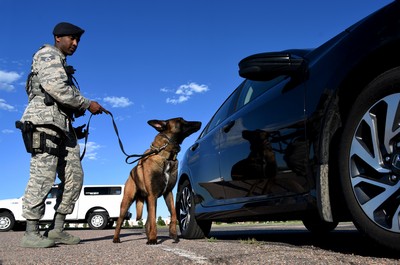
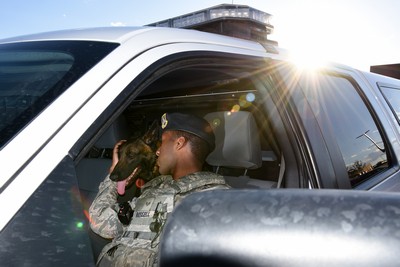
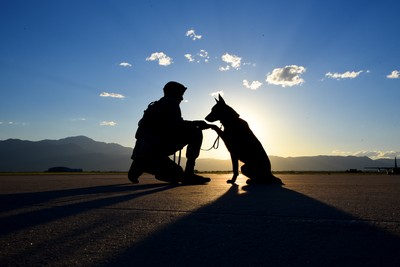
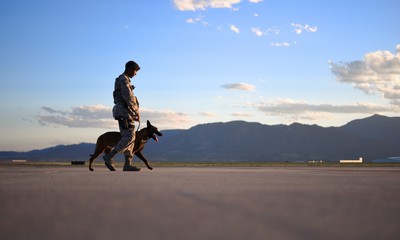
A Dog and his Handler
6/21/2016 - PETERSON AIR FORCE BASE, Colo. -- (This feature is part of the "Through Airmen's Eyes" series. These stories focus on individual Airmen, highlighting their Air Force story.)
The strength of a working relationship can grow exponentially when, at the office, a co-worker jumps all around his cage recklessly wagging his tail, ready to cover faces with big, fat, slobbery kisses.
That is the reality for a military working dog handler in the 21st Security Forces Squadron.
Senior Airman Tariq Russell and his dog, Ppaul, rely on the relationship they developed with each other to create a safe working environment while protecting Airmen at Peterson Air Force Base.
Thanks partly to his father, Russell's love for dogs began when he was a young boy growing up in Southern California.
"Since I can remember, my father has been breeding dogs," Russell said. "We had around 20 dogs in my backyard at any given time and because of that upbringing – that's what interested me most about being a military working dog handler and working with these dogs."
Conversely, Russell pointed out that his passion for dogs had some growing to do in the beginning.
"The first dog that I had growing up was a Rottweiler," Russell said. "I was absolutely terrified of it at first. However, once I got more exposed to dogs and became more accustomed to them, that's when my fascination took off and it was just a whole other experience from then on."
Fast forward to February 2016 and Russell is now a graduate of canine school and a fully certified MWD handler. He was ecstatic to learn about the dog that would accompany him during every working hour from here on out, he said.
"When I asked about when I was going to get my dog, I was told by my flight chief that the dog I would be assigned to was super independent and tough," Russell said. "He likes to boss people around and wants to be in charge. They said it was going to be a while."
Russell said he knew from the moment he met Ppaul, his MWD, he was in for a challenge.
"He had a stigma about him," Russell said. "He was aggressive and would bite you if you tried to correct him. He wasn't very handler friendly when I first got him."
After many bites, hours of training and hundreds of corrections, Ppaul began to show signs of growth. The bond was there, and it was only a matter of time before it became unbreakable, he said. Russell knew there was only one more test before he knew he had the trust of Ppaul.
"I was told that he didn't like to be picked up," Russell said. "I promised myself never to do it because I was told he would bite your face if you tried. I don't know why, but one day I thought to myself 'I'm going to try it,' so I picked him up. To my surprise, he had no reaction and responded very well. From that day, I knew we would make an amazing MWD team."
Since that day, the working relationship between Russell and Ppaul has been so stellar it was noticed by Russell's trainers and leadership team.
"I've been told a few different times that Ppaul and I work extremely well together and that we are a great fit," Russell said. "There's an unbelievable feeling that comes over me when I hear that. I just think back to the day when I was told he was going to be a hard dog to work with and knowing firsthand how much we have grown together – I feel lucky."
Sadly, Russell is scheduled to leave for Joint Base Elmendorf-Richardson, Alaska, this fall and will have to say goodbye to Ppaul. Russell said he is already dreading leaving Ppaul behind, but he is doing his best to make sure his buddy won't be without companionship.
"I don't want him sitting in his kennel for days or weeks without anything to do," Russell said. "That's why I have been already asking my supervisors if we have a handler for him when I leave. I know he will be in good hands though. I'm just going to miss him a lot."
Read Original Article...
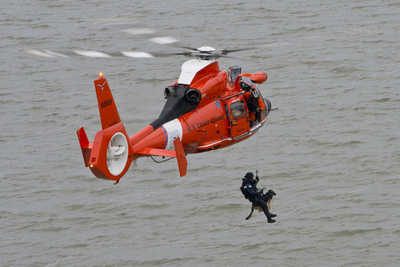
A Coast Guard K-9 handler with the Marine Safety and Security Team in Galveston, Texas and his dog are lowered to boat from a Coast Guard MH-65 Dolphin from Air Station Houston, Feb. 7, 2014. The hoist was part of a training evolution designed to acclimate the dog and handler with the aerial entry process..
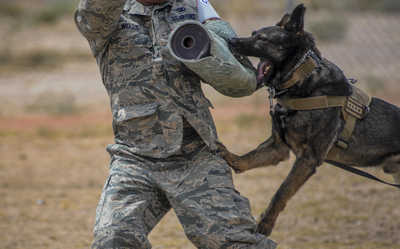
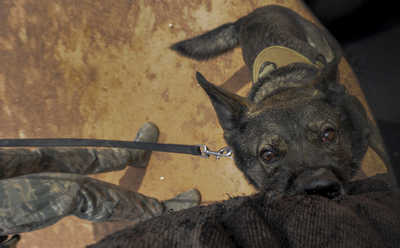
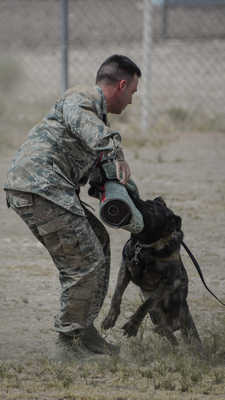
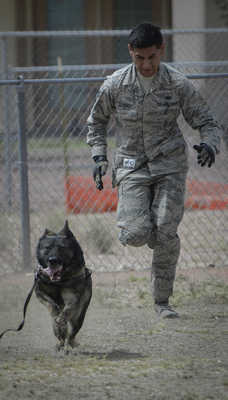
'K-9 leads way'
4/19/2016 - NELLIS AIR FORCE BASE, Nev.— To say that a strong bond between a military working dog and their handler is crucial is an understatement, particularly in a career field where the dog and the handler rely heavily upon each other in high pressure and potentially dangerous situations.
The relationship between MWD and handler requires a greatly heightened level of communication and understanding than normally found throughout the Air Force.
Staff Sgt. Adrian Alvarez, 99th Security Forces Squadron military working dog handler, and his military working dog, ‘PJ’, showed a small part of what a handler and working dog are capable of during a demonstration on April 7, 2016, at Nellis Air Force Base, Nev.
“When you look at a demonstration, it shows the capabilities and obedience of our dogs and also serves as a dual purpose as the public gets to see and understand that our dogs do bite and they do attack,” said Tech. Sgt. Christopher Hinds, 99th SFS kennel master. “It serves as a natural deterrent.”
While demonstrations serve as a good way to display and inform the public of the capabilities of MWDs, they only highlight a very small portion of their mission and capabilities of the handler and the dog.
“Primarily, our mission is to provide capabilities for narcotic and explosive detection as well as patrol work.” said Hinds.
Due to the high risk nature of their mission there are no room for mistakes, which is why the handler and dog go through rigorous training at Joint Base San Antonio-Lackland before becoming operational.
“The handlers go through a 55-day training course,” said Hinds. “There they will learn all the basic functions of the medical portion from how to treat a dog to some basic advance medical. They will learn how to control the dog through the patrol training, which includes the bite work, obedience and marching.
“Next, they will go through the detection portion. During this portion, the handler will learn how to work a dog and how to actually find the odors and learn what the dogs do when they react to the odor.”
The MWDs go through training just as intense as what the handler goes through during the training course.
“The dog itself is on a 120-day timetable where they have to learn how to do detection,” said Hinds. “Typically, the training is broken in half, 60 days of detection and 60 days of the patrol work, bite work and obedience. The dog will then go through formal certifications and if they pass the certifications they will be assigned to a base.”
MWDs are only trained in one specialty: to be explosive detection dogs or narcotic detection dogs.
“You will never have a dog that does both as far as narcotics and explosiveness,” said Alvarez. “The reason being is if the dog were to sit the handler wouldn’t know if it had detected a bomb, explosive or drugs. You will find a dog that is narcotic and patrol or explosive detection and patrol but never explosive and narcotic detection.”
After the dog passes their certifications, they have to wait anywhere from 15 to 60 days before they are stationed at their new base.
“Once at the base, it’s kind of a little reset for the dog,” said Hinds. “We teach a little bit more of the basic tasks and make sure that they remember it because just like a human if you don’t practice something you will forgot. So we spin the dog back up and get them to what we associate as a three-level.
“From there, a team will certify within 60 days and once they meet the certification standards that’s when they get into more of the advanced work.”
It is also during this time that the crucial relationship between handler and dog starts to form. It is a relationship built on trust as both the handler and dog depend on each other.
“The relationship between a handler and his dog is awesome,” said Alvarez. “It’s almost like your own kid. You work like a team; without you the dog can’t do its job and vice versa. You grow that bond and it’s hard to sometimes remember that the dog is a military working dog and not yours because the bond is so strong.
“At the end of the day your dog is a reflection of you. If your dog is out there kicking butt and doing what is has to do, it shows that the handler knows what he is doing. If not, it’s a negative reflection on the handler. You complement each other.”
With a heightened sensitivity of smell, a military working dog is able to sniff out the slightest trace of explosive material or narcotics. This makes the military working dog unit indispensable to the Air Force.
“There is no machine that can replace what a dog does,” said Hinds. “The only thing the dog can lose is proficiency. We do so much training with them we are able detect that before it ever becomes an issue in the field. A dog is better than a machine any day of the week and they are loyal.”
The constant training coupled with the unique bond between handler and dog is what allows the 99th SFS military working dog unit to be mission ready and consistently perform at the highest level.
Read More...


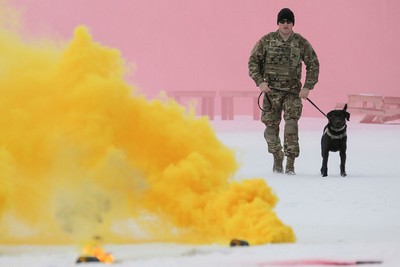
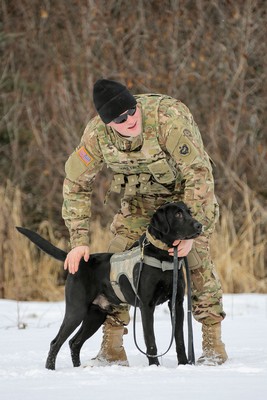
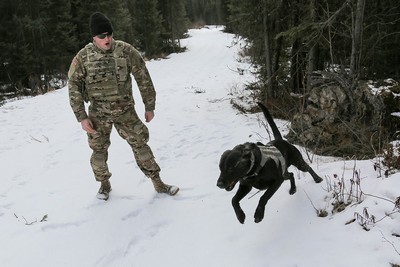
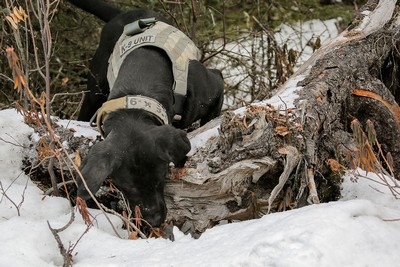

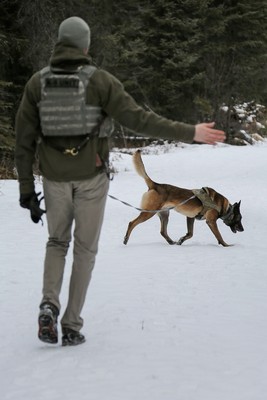
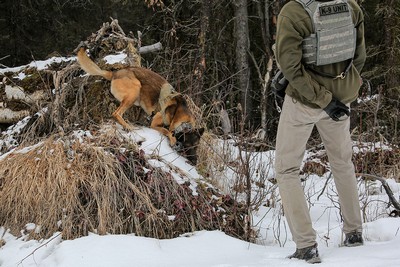
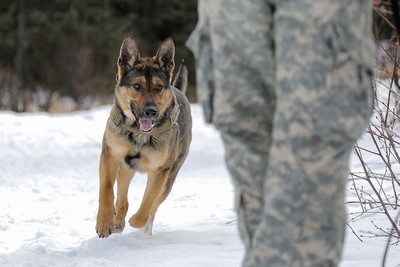
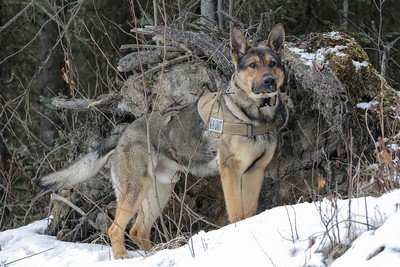
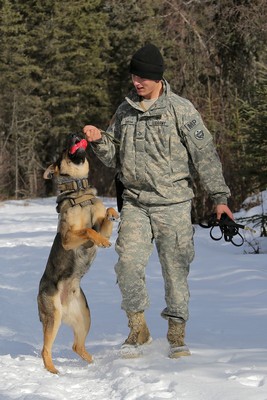

Soldier and Airmen dog handlers participate in joint training
3/23/2016 - JOINT BASE ELMENDORF-RICHARDSON, Alaska -- Soldiers of the 549th Military Working Dog Detachment and Airmen of the 673d Security Forces Squadron participated in joint explosives-detection training on Joint Base Elmendorf-Richardson March 17, 2016.
While the training may be performed regularly by the Army and the Air Force, the joint aspect is what made this event significant.
"In the past we've tried to do [joint training] monthly or a couple times quarterly, but due to manning and [other restrictions] here, it hasn't taken place," said Army Staff Sgt. Daniel Turner, 549th MWD kennel master.
"We're trying to build that relationship back up and get everyone on track as far as ... being able to work together," he said. "We are hoping to have joint training as something that will happen in a much more regular basis."
Since JBER is a joint installation, there is a greater need for the coordination of military police and security forces.
It's paramount for dog handlers from both branches to know what each side is going to bring in the event of an emergency, said Sam Finney, 673d SFS kennel master.
The training was set up very much like a search that would be performed in a remote village, to mimic what dog handlers may experience in a deployed environment, said Spc. Jared Schultz, a 549th MWD dog handler.
"Very few times are we actually going to search an RV lot or a warehouse in a deployed environment," he said. "Not that it couldn't happen, but it's not as likely. This is why we train all these different areas."
Further importance of joint training lies in the ability to share training practices where service members can see training methods in practice that appeal to different learning styles.
"Just like a person, [all dogs learn differently]," Schultz said. "Someone might be a visual learner where another may need to hear something. [This is the same for a dog] and it's all about how you can get through to the dog. When you get to see other people [train] you get to see some of their ideas or concepts played out. Even if they don't work for you and your dog, you can learn from them and ... you have a tool that you can add to your toolbox. In the end, it's up to you what tools you put into that box."
Read More...


Ellsworth first CONUS base to run indoor K-9 facility
1-1-2016 ELLSWORTH AIR FORCE BASE, S.D. (AFNS) -- Ellsworth Air Force Base became the first Air Force base in the continental U.S. to have an indoor training facility for its four-legged defenders when it became operational last fall.
The new facility, located in Dock 32, provides an array of features and amenities for 28th Security Forces Squadron military working dog handlers to train their partners and helps reduce the loss of training time due to austere weather.
After seven months of planning and approval, a $100,000 contract was awarded to a local business to complete the renovations that included removing aircraft parts and installing turf, barriers and obstacles to transform the aircraft hangar into a training facility for military working dogs.
Tech. Sgt. Abraham Wheeler, a 28th SFS kennel master, said the new facility provides MWDs and their handlers the ability to train year-round, regardless of weather conditions.
"Being at Ellsworth, there is a good chance we can be covered in snow for five months out of the year," Wheeler said. "The indoor facility allows us to train every day of the year -- rain, snow or shine."
He added that the new facility allows teams to train on a variety of topics ranging from basic obedience training to realistic patrol scenarios.
"The facility minimizes training time lost due to inclement weather," said Wheeler, who has been a handler for eight years. "It also gives an isolated area for the dogs to work on issues they may have with minimum distractions."
While the new facility may be slightly smaller than the outdoor area, it still includes the obstacle course, patrol work field and detection training environments.
"My favorite part is how versatile it is," Wheeler said. "We can do so many things and not worry about hurting one of the dogs due to cold weather."
Wheeler said he hopes other bases will follow suit, especially northern bases, where freezing temperatures and fierce winds hinder training.
Enclosed and heated, the facility also helps the dogs stay healthy and train in a safe environment, Wheeler said.
"We are extremely grateful to be the first base to have an indoor military working dog training facility," he continued. "(The ability to train inside) benefits the dogs, handlers, and most importantly, the Air Force."
Read More...
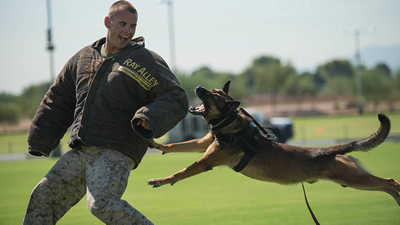
Sgt. Derek Patrick, a military working dog trainer from Marine Corps Base Camp Pendleton, demonstrates the capabilities of his military working dog at the fields behind the University of Phoenix Stadium at Glendale, Arizona, Sept. 11, 2015. The demonstration was part of Marine Week Phoenix, which allows the Marine Corps to showcase its traditions, history, and values.

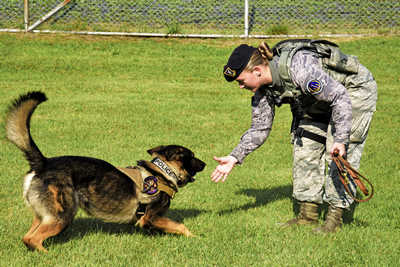
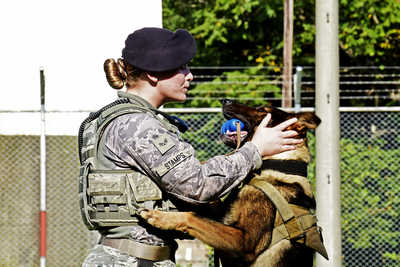
Stepping stones: An Airman’s path to K-9 career
9/24/2015 - MISAWA AIR BASE, Japan - Face-to-face with an energetic German Sheppard, Senior Airman Alyssa Stamps, 35th Security Forces Squadron military working dog handler, makes a grab for the ball. Now holding the cherished reward, she chucks it across the yard and the dog stampedes after it. Instead of returning to her with an accomplished strut, he sits with his back to her in the corner of the yard and refuses to cooperate.
Stamps describes this as “battling a streak of stubbornness” taken on during the two-week rapport stage destined to nurture their new handler-MWD relationship. Although frustrating, these visits with her new dog, Elvis, are just the beginning of her dream becoming a reality.
From living beside dogs as a child to joining the Air Force as a security forces Airman, Stamps has knowingly and unknowingly prepared for the duty of an MWD handler.
Read More...
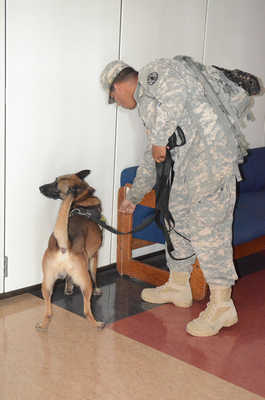

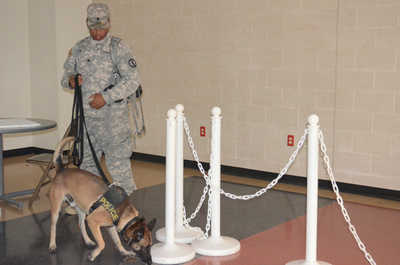
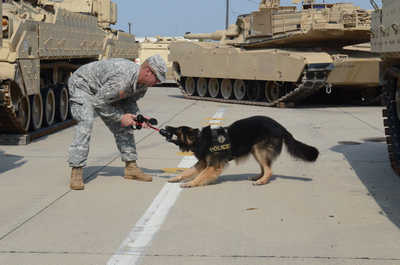

Fort Hood's Annual Canine Certification Course
9/11/2015 - Military police officers and their canine companions from various states gathered at the Robert Gray Airfield on West Fort Hood, Texas, Aug. 28, to certify their military working dogs for deployment.
The military working dog certification course is a week-long event testing the dog’s ability to properly navigate through buildings and inspect areas in search of explosives and drug paraphernalia.
Teams started testing on Monday, which allowed the canine’s time to correct any deficiencies or areas of concern by Friday, said Staff Sgt. William Morton, plans and operations non-commissioned officer for the 226th Military Working Dog Detachment, 89th Military Police Brigade at Fort Hood.
Read More...
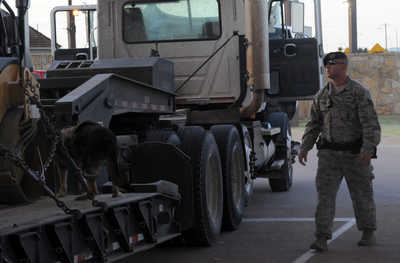
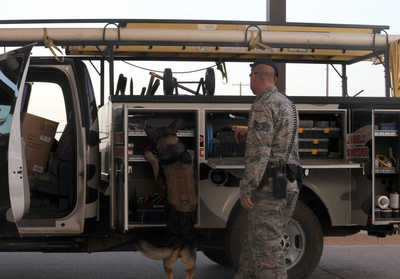
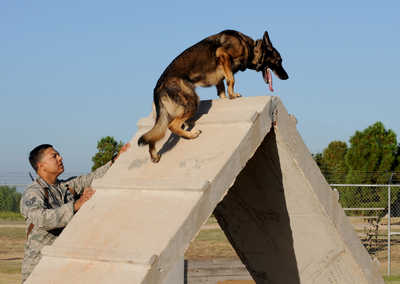
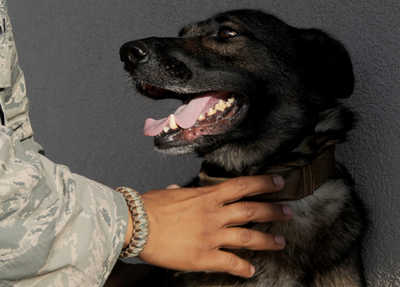
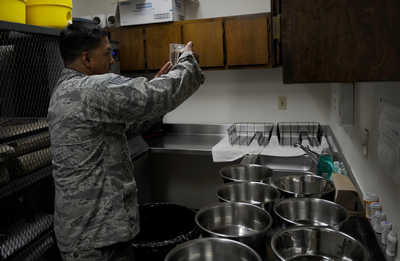
A bond that can never be broken
9/23/2015 - DYESS AIR FORCE BASE, Texas -- With ears up, eyes open and not a single movement until a command is given by their handler, military working dogs display great discipline and obedience.
Military working dogs begin their training at Joint Base San Antonio-Lackland, Texas, between the ages of 1 and 2 years old and go through the 60 - 90 day Department of Defense Military Working Dog Program.
During the program the dogs are taught to detect drugs and explosives. The dogs are bred by the 341st Training Squadron at Lackland and are raised until they qualify for the program. The handlers also receive training through the 11-week Military Working Dog Handler course to learn fundamentals before working with a dog.
Read More...
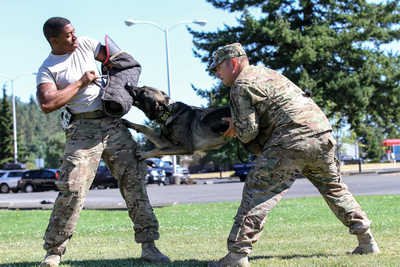


Face of Defense: From Puppy to Police Dog
JOINT BASE LEWIS-MCCHORD, Wash., August 7, 2015 — He jumps, he drools, and he sheds like it’s summer all year long, but this is no ordinary pup. This dog is an invaluable part of team that could one day save lives and capture dangerous criminals.
Army Staff Sgt. Adam Serella, a military working dog handler with the 95th Military Police Detachment here, is busy training Greco -- a newly-acquired military working dog, fresh from Joint Base San Antonio, Texas. Greco left there with the basics, just like the airmen who attend Air Force basic training at JBSA, and now he’s ready to learn what it means to really be a MWD.
Read More...
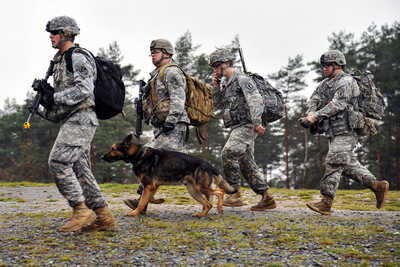
U.S. paratroopers and a K-9 military working dog team conduct an assault in an urban environment during training at the 7th Army Joint Multinational Training Command's Grafenwoehr Training Area in Germany, Nov. 19, 2014.
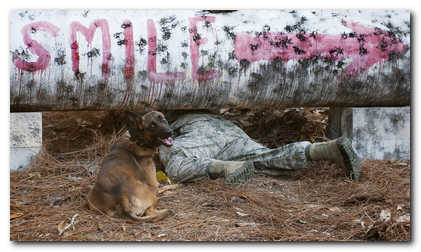
A muzzle is placed on an Air Force military working dog prior to a patrol scenario during the Emerald Coast K-9 Clash at Hurlburt Field, Fla., Nov. 15, 2014. Military working dog jobs require a high degree of obedience, they can work with or without a leash or harness and are taught when it is and isn’t appropriate to attack.
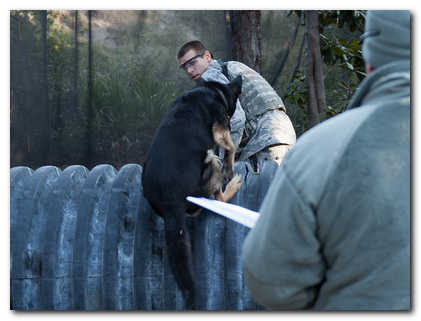
Staff Sgt. Shane Masse, 96th Security Forces Squadron military working dog handler, and his partner, Pako, take down an uncompliant suspect during the Emerald Coast K-9 Clash at Hurlburt Field, Fla., Nov. 15, 2014. Competitors participated in variety of events during the clash, which included searching buildings, navigating a jungle obstacle course and patrolling scenarios.
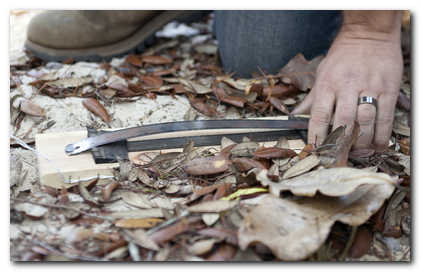
A mock improvised explosive device is set up for the Tactical Obedience Jungle Obstacle Course during the Emerald Coast K-9 Clash at Hurlburt Field, Fla., Nov. 15, 2014. Competitors participated in variety of events during the clash including searching buildings, navigating a jungle obstacle course and patrolling scenarios.

Staff Sgt. Philip Hines, with the 1st Special Operations Security Forces Squadron military working dog handler, and his partner, Szuli, crawl under an obstacle during the Emerald Coast K-9 Clash at Hurlburt Field, Fla., Nov. 15, 2014. The competition allowed Department of Defense military working dog handler teams to test their individual knowledge of dog-handling and exchange experiences with each other.

Staff Sgt. Philip Hines, 1st Special Operations Security Forces Squadron military working dog handler, and his K-9, Szuli, jump an obstacle during the Emerald Coast K-9 Clash at Hurlburt Field, Fla., Nov. 15, 2014. Participants were judged in a variety of areas including team work, navigation, tactics and K-9 control.
Hurlburt hosts Emerald Coast K-9 Clash
11/17/2014 - HURLBURT FIELD, FL Air Force and Army military working dog handlers and their four-legged partners gathered for the Emerald Coast K-9 Clash on Hurlburt Field, Fla., Nov. 15.
The event, hosted by the 1st Special Operations Security Forces Squadron, is the first of its kind to be held here.
The K-9 Clash allowed military working dog teams from across the Department of Defense to come together, garner experience from each other and test their knowledge in dog-handling, through various competitions, according to Staff Sgt. April Walker, event coordinator and 1st SOSFS military working dog trainer.
“For our guys, participating in this event has been really amazing,” said Walker. “They were able to train, compete against and work with other dog handlers; expanding their network of people within our career field.”
Read More...
K-9s at work
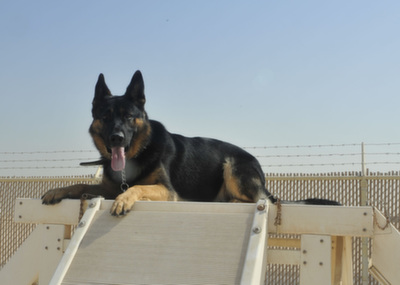
Renato a 3-year-old military working dog with the 379th Expeditionary Security Forces Squadron, takes a break from decoy training at Al Udeid Air Base, Qatar, Sept. 24, 2014. MWDs are used throughout the military to detect explosive devices and illegal narcotics and assist during patrol on military installations worldwide.
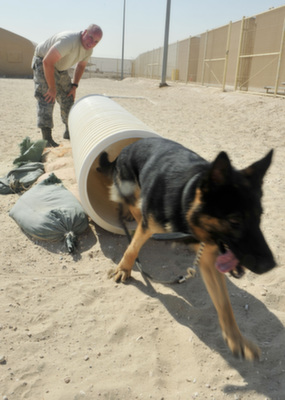
Military working dog, Renato, runs through a tunnel under the instruction of U.S. Air Force Tech. Sgt. Sean Schwartz, 379th Security Forces Squadron K-9 handler at Al Udeid Air Base, Qatar, Sept. 24, 2014. Military working dogs continuously train even in deployed locations, to maintain standards with all their movements.

Renato, a 3-year-old military working dog with the 379th Expeditionary Security Forces Squadron, jumps over an obstacle during training at Al Udeid Air Base, Qatar, Sept. 24, 2014. Military working dogs serve as a psychological deterrent and are trained to attack on command.
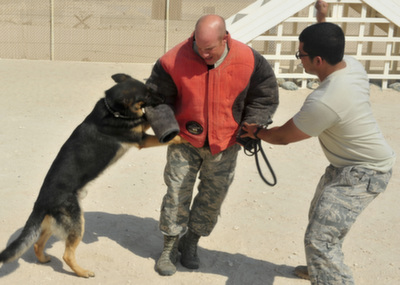
U.S. Air Force Staff Sgt. Miguel Marrero, 379th Security Forces Squadron K-9 handler, instructs Military Working Dog Renato during training exercises at Al Udeid Air Base, Qatar, Sept. 24, 2014. K-9 handlers and military working dogs are trained for situations both in and out of combat.
Read More...

MWD handlers face obstacles
9/19/2014 - TRAVIS AIR FORCE BASE, Calif. -- The 60th Security Forces Squadron Military Working Dog team and the 60th Maintenance Squadron Aircraft Structural Welding shop are two units that would not normally work closely together.
However, in support of their four-legged wingmen, the Airmen are overcoming financial hurdles by building their own training obstacles.
"Our current training obstacles for the canines are around 15 years old, and they're pretty beat up," said Tech. Sgt. Chris Smith, 60th SFS MWD kennel master. "It would cost the Air Force around $28,000, plus shipping, to replace these items."
The obstacles the MWD team sought were a ladder, dog-walk with steps, teeter totter and four boxes for bad guys to hide in during detection training. With only $3,000 available, the MWD handlers turned to innovation.
Read More...
3rd LE Bn. Marines Fast Rope with Dogs
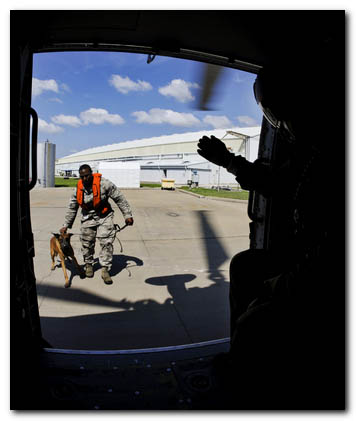


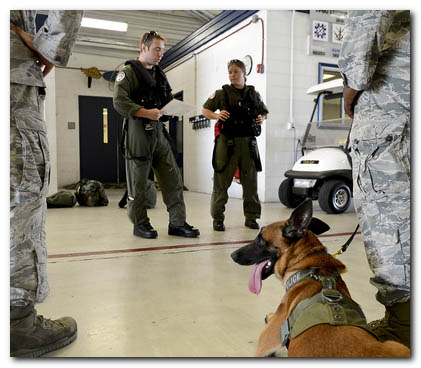
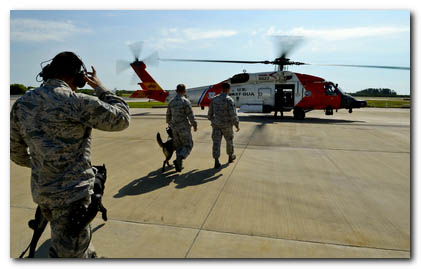
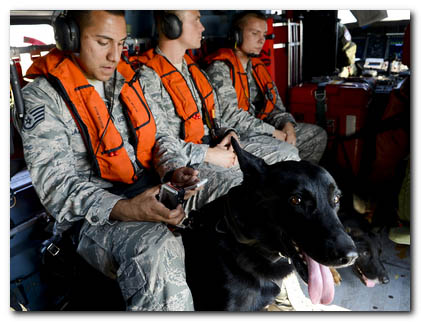

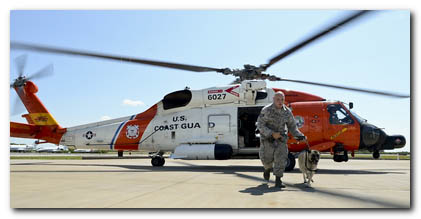
K-9 airpower
7/9/2014 - CLEARWATER, Fla. -- The 6th Security Forces Squadron military working dog section teamed up with the U.S. Coast Guard Air Station in Clearwater, Florida, to familiarize four MWD's with being in the presence of and flying in a helicopter, June 30, 2014.
This experience allowed the handlers to evaluate their four-legged partners' reactions when riding in, as well as, jumping in and out of a helicopter.
Conditioning a dog prior to a deployment is crucial. This reassures a handler it can depend on their partner to perform under hectic circumstances.
Read More...
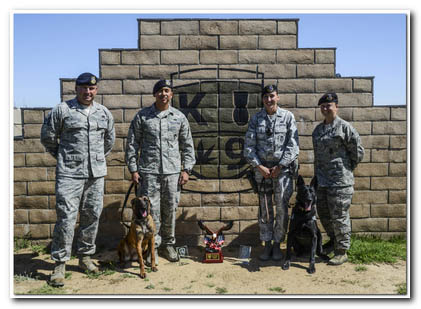

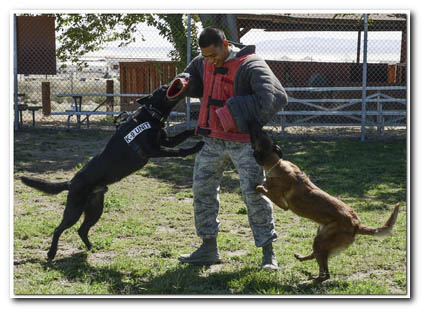
Military Working Dog sniffs out three awards
6/4/2014 - EDWARDS AIR FORCE BASE, Calif. -- Staff Sgt. Kathryn Goldman and her working dog Rolf from the 412th Security Forces Squadron took home three first place trophies from the Western State Police Canine Association Trial. The two-day competition was held May 16-17 at Travis Air Force Base, Calif. The competition brought working dogs from the military, law enforcement, homeland security and many other organizations. In all, there were 66 competitors from 29 agencies.
The first day of competition was detection, the next day was patrol and obedience.
"I didn't know what to expect," said Goldman. "I was kind of intimidated and overwhelmed when I saw the first day how many cars there were along with dogs and handlers."
Read More...
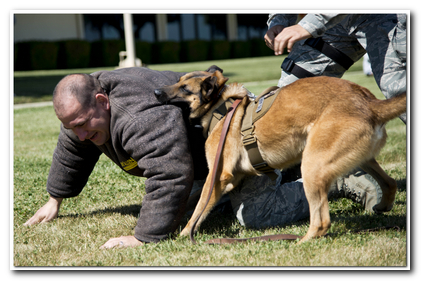

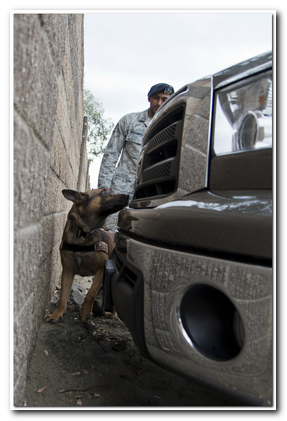

Dog eat dog: Travis set to host K9 competition
5/9/2014 - TRAVIS AIR FORCE BASE, Calif. -- Travis is hosting the 2014 Defenders K9 Trials May 16 and 17 where military and civilian police dogs will show off their best.
The trials, organized by the Travis Defenders Association and the Western States Police Canine Association, has 39 different police agencies from Northern California set to come out to Travis to compete with their dogs. Teams will also be coming from Beale and Edwards Air Force Base.
These trials are the season opener for the Western States Police Canine Association. These trials also mark a first for Travis and a first for the Western States Police Canine Association having a military installation hosting the trials.
Read More...

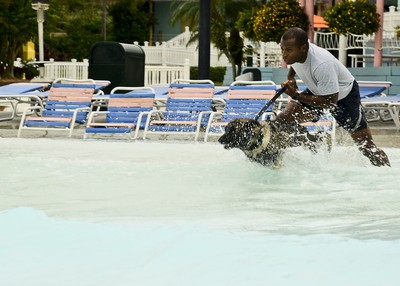
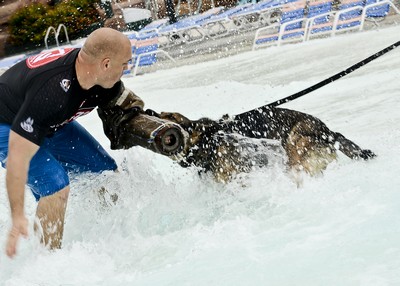
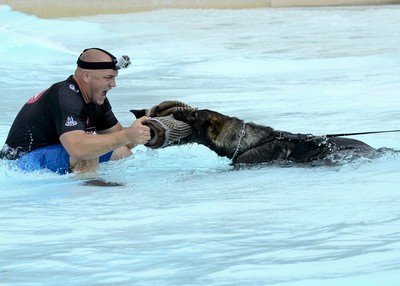
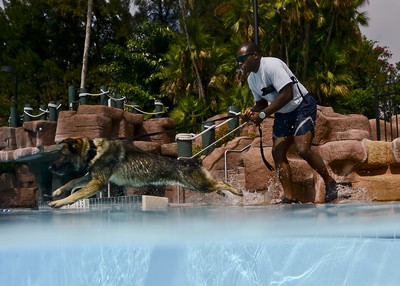


K-9s conquer water
10/24/2013 - MACDILL AIR FORCE BASE, Fla. -- "Halt! Halt! Halt! Or I will release my dog," was the common phrase heard throughout the 5-hour controlled aggression water training for military and police dogs Oct. 16, 2013.
Tampa, Largo, Clearwater, Hernando, and Pinellas County police department K-9 units joined forces with the 6th Security Forces Squadron military working dogs to safely introduce controlled aggression in water at a local water park in Tampa, Fla.
A total of 31 dynamic duos, five of which were MWD, ran through three various exercises involving the dogs jumping into deep bodies of water and swimming to apprehend decoy suspects.
Water training is not part of the standardized training MWDs receive; however, being that MacDill Air Force Base is surrounded by water it's beneficial for the K-9 here to have this training. MacDill AFBs geographical location is unique. The base's 7.2 miles of coastline makes its physical security unlike most Air Force bases.
Read More...
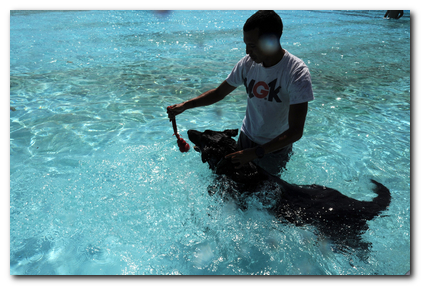

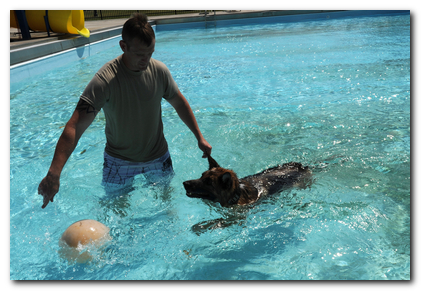

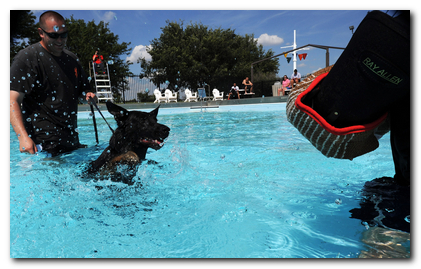


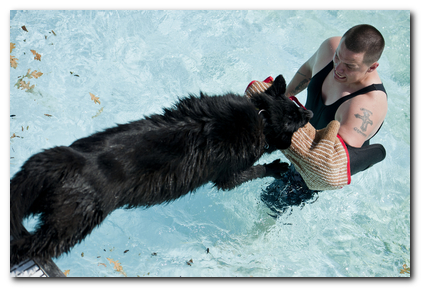

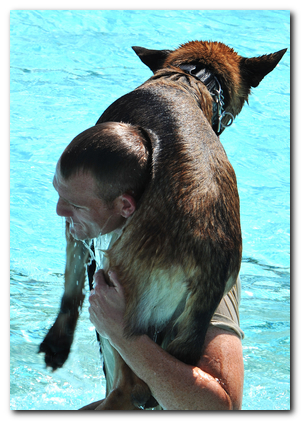
Security Forces conducts K-9 water training
9/12/2013 - 22nd Security Forces military working dog and handlers during water training, Sept. 10, 2013, at McConnell Air Force Base, Kan. The kennel section trains their dogs once a year at the pool, after it has been closed for the winter season. The MWD section takes advantage of the training when available due to the dogs’ limited exposure to water.
Read More...

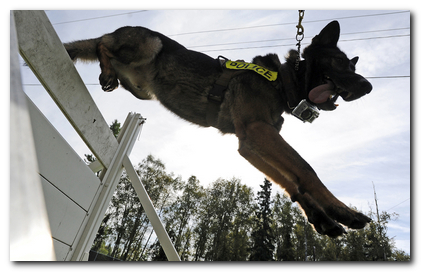
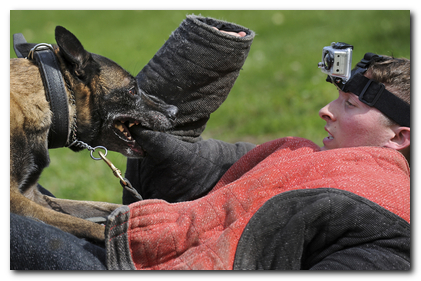
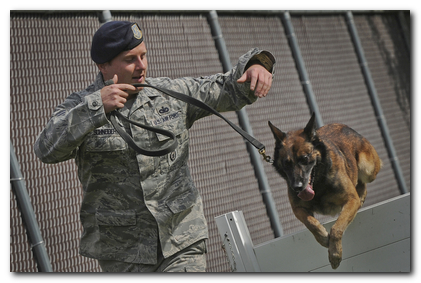
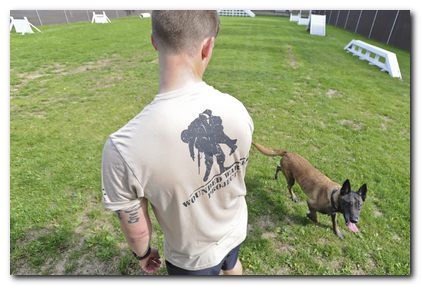
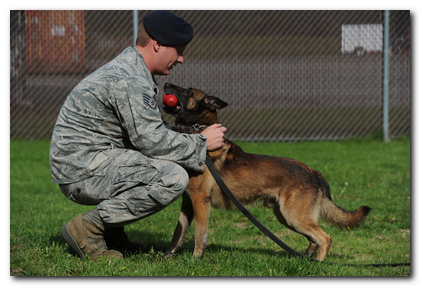


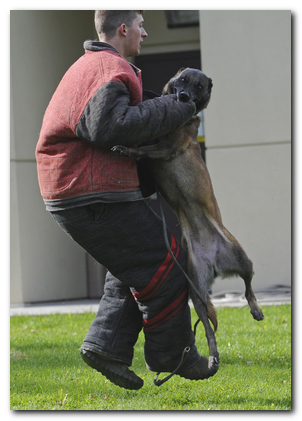


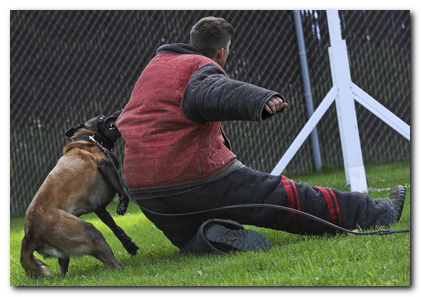
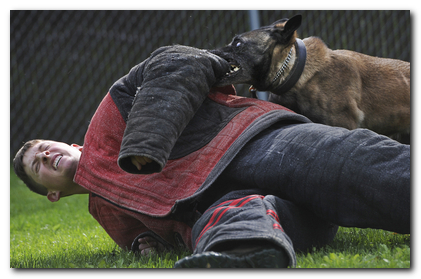
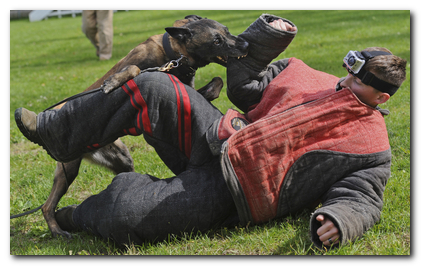

Military working dogs wag their tails and sharpen their skills at JBER
9/5/2013 - JOINT BASE ELMENDORF-RICHARDSON, Alaska -- The sun hung low over the morning horizon. The rumble of traffic melted into a muffled rustle of grass, damp and short, then of footfalls rushing closer and faster, faster, faster. The jangle of brass clinked in the chill air, punctuation marks for panted breaths. A single bark echoed, then another, pushed before the quickening paces like a sound wave of compressed air as it leaves a muzzle--here not a rifle but the slobbery, snarling muzzle of a dog.
A third bark was swallowed in a growl, the unmistakable, guttural vibration of a dog nearing its prey. The animal leapt and, ferocious and inescapable, closed the final yards in the air.
The target toppled to the ground in a flurry of sharp white canine teeth and sleek brown canine fur. He kicked. He flailed and struggled. The dog remained clamped, jaw shaking, eyes widened, as loyal to the task at hand as to his keeper. He ripped and pulled until a shouted "OUT" rang out. The dog obeyed on cue and instantly released its grip. The animal sat on its back haunches and waited patiently, tail wagging, tongue hanging to one side.
Dog handlers with the 673d Security Forces Squadron volunteer for a particularly ruff--rough, even--line of work. The road to becoming a military working dog handler is lengthy. Airmen must possess three years of experience in security forces and must be accepted for work with canines. Yet the road for the dogs themselves is nothing to wag a tail at, either.
Read More...
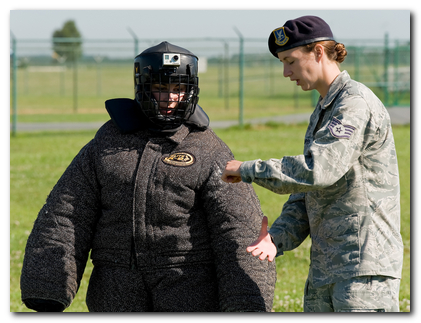
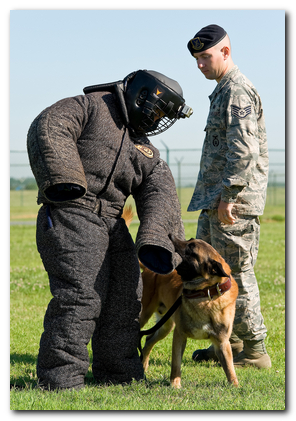
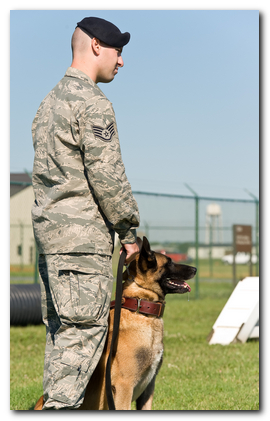

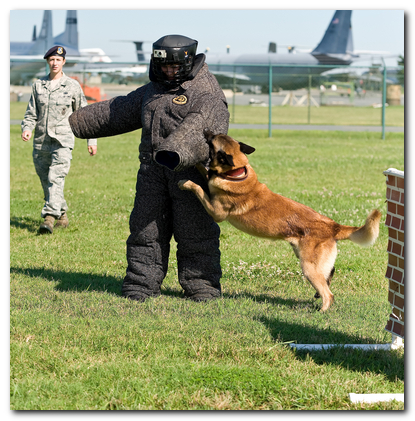

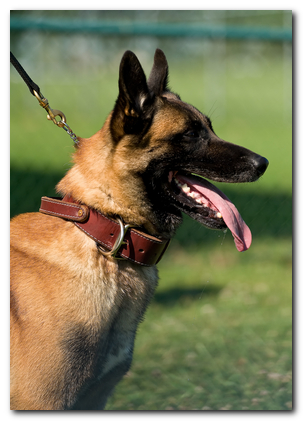

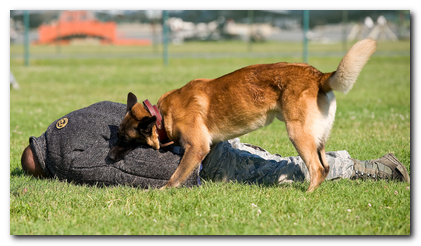

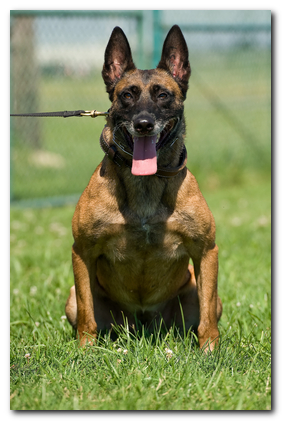

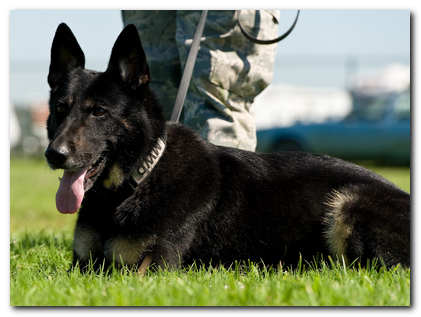
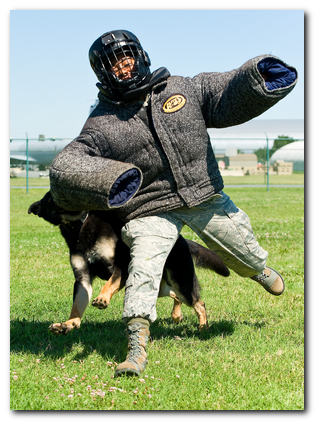
8/8/2013 436th Airlift Wing - Military working dogs sink their teeth into local media
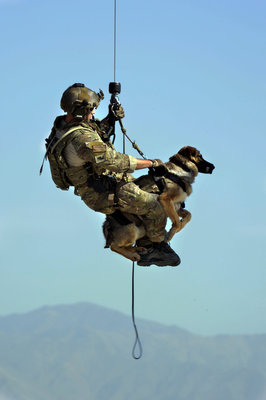
Pararescueman Senior Airman Jason Fischman hoists an Army tactical explosive detection dog into a HH-60G Pave Hawk during a joint rescue training scenario June 21, 2013, at Bagram Airfield, Afghanistan. This training was a first for both branches and prepared them for future rescue missions. Fischman is deployed to 83rd Expeditionary Rescue Squadron from Royal Air Force Lakenheath, England.
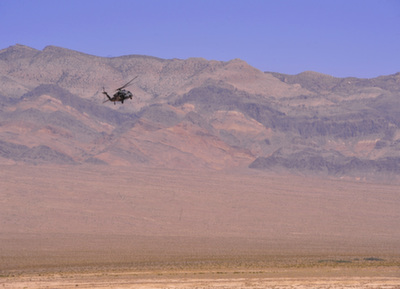
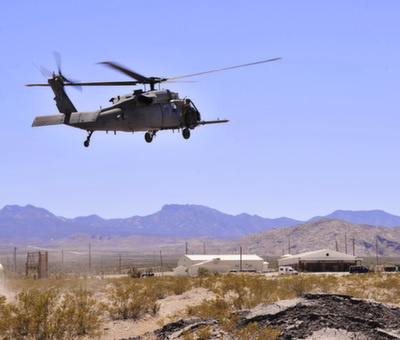

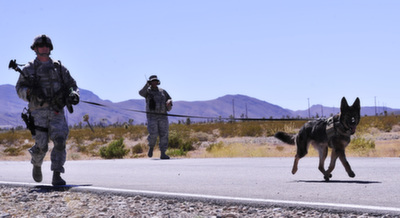
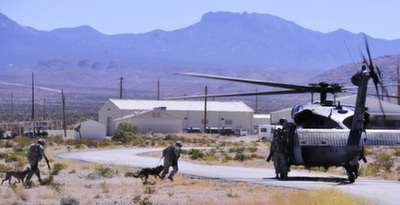
MWD helicopter training takes flight
6/18/2013 - NEVADA TEST AND TRAINING RANGE, Nev. -- The 99th Ground Combat Training Squadron and 66th Rescue Squadron performed new military working dog helicopter operations training for the first time here June 13.
During this type of training handlers and their dogs typically enter a stationary helicopter before it is turned on, then once in place the aircraft is turned on and off again. However, the new training requires the handlers and their dogs to load onto a running helicopter, fly to an area where they will perform exercises and then take a return flight.
Staff Sgt. Wendy Montellese, 99th GCTS military working dog instructor, said the training has benefits for both of the squadrons.
Read More...

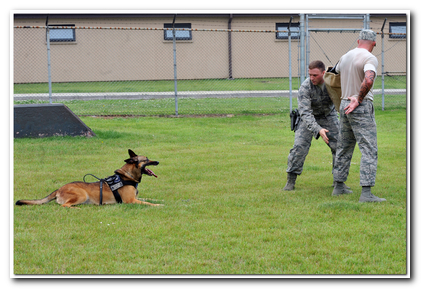
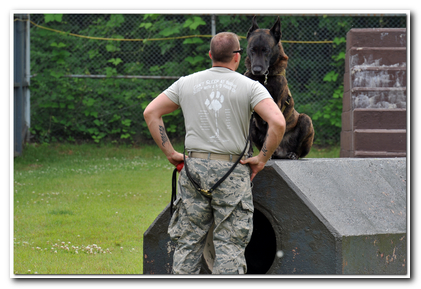

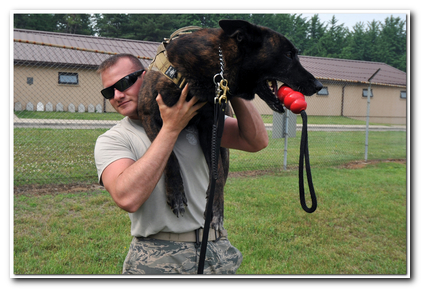 >
>
Photos: Daily training keeps K-9s sharp
6/14/2013 - Daily training at Osan Air Base, Republic of Korea
Read More...
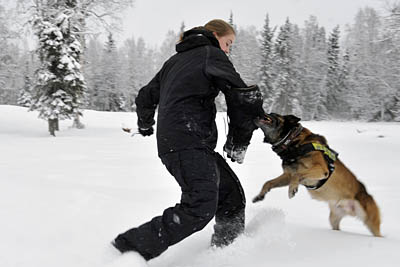

JBER Airmen keep own, military dogs' skills sharp
3/7/2013 - JOINT BASE ELNENDORF-RICHARDSON, Alaska -- Loud barks could be heard yards away as 673d Security Forces Squadron dog handlers prepared their assigned dogs for standard dog training at the Eagleglen golf course on JBER.
"Certain requirements are levied when it comes to qualifying as a military dog-handler," said Tech Sgt. Scott Heise, 673d Security Squadron military dog kennel master.
"Not only do you have to be willing to show the effort to become a military dog handler," Heise said. "You also have to be a three-year experienced security forces member, possess your 5-level skill training and have an open cross-training window."
Read More...

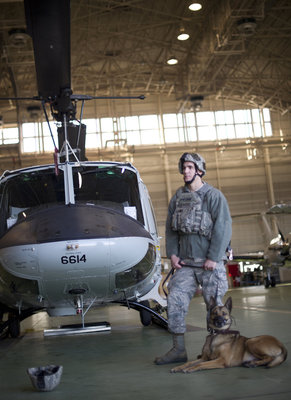
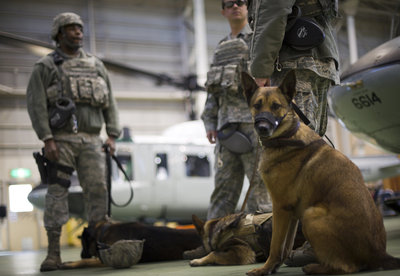

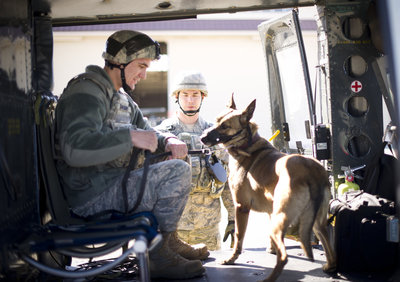
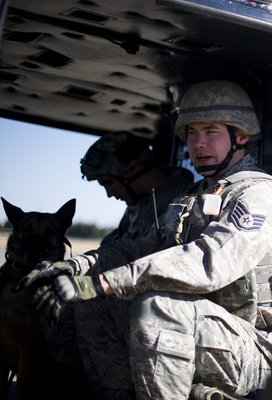
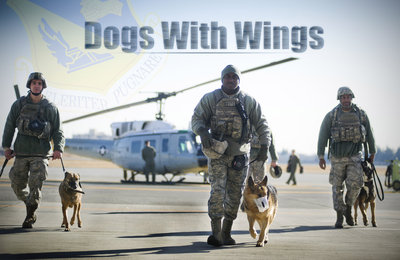
What has four legs and flies?
2/25/2013 - YOKOTA AIR BASE, Japan -- Who said you can't teach an old dog new tricks?
Security Forces Airmen and their K-9 partners learn to fly during Readiness Week Feb. 25 through March 1 at Yokota Air Base, Japan.
Military Working Dogs train with security forces members to familiarize both handlers and the dogs to a unique mode of transportation - the UH-1 helicopter.
Read More...
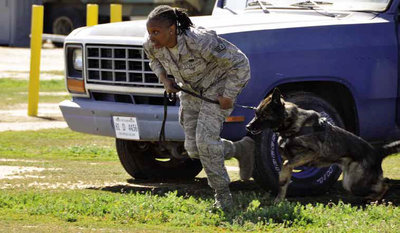

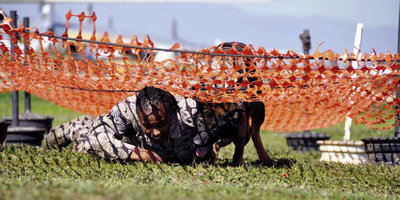
Iron Dawg II: Military working dog handlers compete for "Top Dog"
2/27/2013 - MARCH AIR RESERVE BASE, CALIF. -- A U.S. Marine and his K9 companion crouch at the starting position, readying for the first task -- securing a seemingly abandoned bread truck. When the signal was given, they take off! After a thorough search and clear, they proceed on to an old pick-up truck to do the same. After which, they advance to three trailers, where the pup takes the low ground under the trailers, and the handler takes the higher route over the
trailers, an unusual stipulation because most K9's instinctively stay with their trainer.
An onlooker might view this as a typical training scenario for a military working dog handler and his K9, but on this occasion, it was a competition where spectators gathered to watch military working dog handlers and their K9s, do battle in the second annual, Iron Dawg competition, held at the March Field Air Museum, Sunday, Feb. 17.
The competition involved nine Marines from Camp Pendleton and Miramar, a Marine veteran and an Airman from Beale Air Force Base, partnered with their respective MWDs. They competed for the title of "Top Dawg," by demonstrating their proficiency in tactical obedience, bite work, detection and endurance.
Read More...
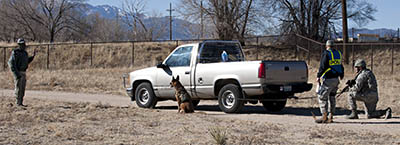
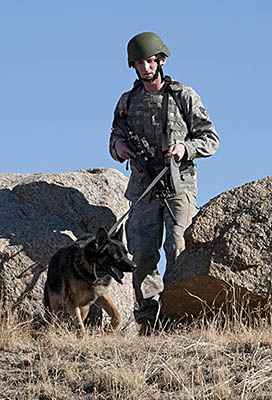
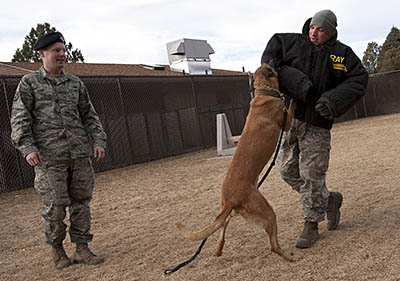
Ruffing it with K9
2/13/2013 - PETERSON AIR FORCE BASE, Colo. -- As an oversized pick-up truck rolled into a dusty gravel lot, the silver trailer in tow was filled with the echoes of barking dogs ready for action. Members of the 21st Security Forces Squadron Military Working Dog section were preparing for training exercises, Jan. 18 to help prepare members that would soon be deploying.
Tech. Sgt. Loren Surley, 21st SFS MWD trainer and supervisor, the leader of the day's exercises, explained the primary intent of this training was to reinforce the teamwork concept between the handlers and their dogs while familiarizing them with 'outside-the-wire' missions searching for drugs, bombs or on patrol.
Having been deployed as a MWD handler, Surley understands the importance of training exercises like this as it relates to safety.
Read More...









